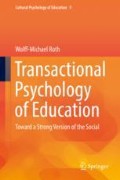Abstract
Hands-on activities and project-based learning are at the heart of many school disciplines. Educational psychologists, too, emphasize the need for children and students – especially those with difficulties in reading – to learn through practical work. As a teacher, I had not been different scheduling 70% or more of classroom time to student-centered activities, where data of some sort where collected or students engaged at their own rate in whatever the curriculum outlined in broad terms. Later, however, I was beginning to take a more critical perspective, wondering about how doing something with your hands was to contribute to conceptual understanding, which, by all accounts of the going constructivist narrative, existed in the form of abstract concepts organized in conceptual frameworks. Having been a middle and high school science teacher for a dozen years, I was beginning to ask others and myself pointed questions including: “How does turning the tap on a burette during a titration help high school chemistry students learn about acids and bases generally and about pH specifically?” or “How is turning the burette tab related to writing out a formula such as pH = – log[H3O]+?” Clearly, at their very heart such questions concern the psychophysical (body–mind) problem. Standard educational psychology, concerned with the development of the mental, has not been able to provide any useful theory about the relationship between practical activity and anything that might be denoted as mental or conceptual.
Access this chapter
Tax calculation will be finalised at checkout
Purchases are for personal use only
Notes
- 1.
Vygotsky wrote about concepts as if these were things, some features of the mind . While discussing his work, I continue using the term. In a transactional theory, however, there would be events of employing concept words on specific occasions, themselves thought as events irreducible to things and structures.
- 2.
Recent analyses of Vygotsky’s work show that he had scarcely used the term internalization or interiorization . These terms rose to importance in the Vygotsky-related literature because of Western scholars, who developed conceptual frameworks very different from those that Vygotsky had intended (Yasnitsky 2019).
References
Deleuze, G., & Guattari, F. (1980). Mille plateaux: Capitalisme et schizophrénie [A thousand plateaus: Capital and schizophrenia]. Paris: Les Éditions de Minuit.
Fox-Keller, E. (1983). A feeling for the organism: The life and work of Barbara McClintock. San Francisco: W. H. Freeman.
Henry, M. (2004). Phénoménologie de la vie III: De l’art et du politique [Phenomenology of life vol. 3: Of art and politics]. Paris: Presses Universitaires de France.
Holzkamp, K. (1993). Lernen: Subjektwissenschaftliche Grundlegung [Learning: Foundation in a science of the subject]. Frankfurt: Campus.
Husserl, E. (1976). Husserliana Band VI. Die Krisis der europäischen Wissenschaften und die transzendentale Phänomenologie. Eine Einleitung in die phänomenologische Philosophie. The Hague: Martinus Nijhoff.
Husserl, E. (2004). Wahrnehmung und Aufmerksamkeit: Texte aus dem Nachlass (pp. 1893–1912). Dordrecht: Springer.
Ingold, T. (2011). Being alive: Essays on movement, knowledge and description. London: Routledge.
Ingold, T. (2013). Making: Anthropology, archeology, art and architecture. London: Routledge.
Kandinsky, W. (1913). Kandinsky 1901–1913. Berlin: Der Sturm.
Kandinsky, W. (1926). Punkt und Linie zu Fläche. Beitrag zur Analyse der malerischen Elemente (2. Auflage). Munich: Albert Langen.
Klee, P. (1980). Gedichte [Poems]. Bern: Arche.
Marx, K., & Engels, F. (1962). Werke Band 23: Das Kapital Band I [Works vol. 23: Capital vol. I]. Berlin: Dietz.
Marx, K., & Engels, F. (1978). Werke Band 3: Die deutsche Ideologie [Works vol. 3: The German ideology]. Berlin: Dietz.
Mead, G. H. (1932). The philosophy of the present. Chicago: University of Chicago Press.
Merleau-Ponty, M. (1964). L’œuil et l’esprit. [Eye and mind]. Paris: Gallimard.
Nietzsche, F. (1922). Nachgelassene Werke: Zweite Abteilung Band XVI [Unpublished works. Part 2 vol. 16]. Leipzig: Alfred Kröner Verlag.
Roth, W.-M., & Roychoudhury, A. (1992). The social construction of scientific concepts or the concept map as conscription device and tool for social thinking in high school science. Science Education, 76, 531–557.
Sheets-Johnstone, M. (2011). The primacy of movement (2nd ed.). Amsterdam: John Benjamins.
Snow, R. E. (1992). Aptitude theory: Yesterday, today, and tomorrow. Educational Psychologist, 27, 5–32.
Vygotskij, L. S. (1934). Myšlenie i reč’ : psixologičeskie issledovanija [Thinking and speaking: psychological investigations]. Moscow: Gosudarstvennoe social’noèskonomičeskoe isdatel’stvo.
Vygotsky, L. S. (1997). The collected works of L. S. Vygotsky, vol. 3: Problems of the theory and history of psychology. New York: Springer.
Watson, J. D. (1996). The annotated and illustrated double helix. New York: Simon & Schuster.
Whitehead, A. N. (1919). An enquiry concerning the principles of natural knowledge. Cambridge: Cambridge University Press.
Whitehead, A. N. (1978). Process and reality: An essay in cosmology. New York: Free Press (First published in 1929).
Wittgenstein, L. (1997). Philosophical investigations/Philosophische Untersuchungen (2nd ed.). Oxford: Blackwell (First published in 1953).
Yasnitsky, A. (2019). Vygotsky’s psychology of superman: From utopia to concrete science. In A. Yasnitsky (Ed.), Questioning Vygotsky’s legacy: Scientific psychology or heroic cult. New York: Routledge.
Author information
Authors and Affiliations
Rights and permissions
Copyright information
© 2019 Springer Nature Switzerland AG
About this chapter
Cite this chapter
Roth, WM. (2019). Growing-Together. In: Transactional Psychology of Education. Cultural Psychology of Education, vol 9. Springer, Cham. https://doi.org/10.1007/978-3-030-04242-4_9
Download citation
DOI: https://doi.org/10.1007/978-3-030-04242-4_9
Published:
Publisher Name: Springer, Cham
Print ISBN: 978-3-030-04241-7
Online ISBN: 978-3-030-04242-4
eBook Packages: EducationEducation (R0)

